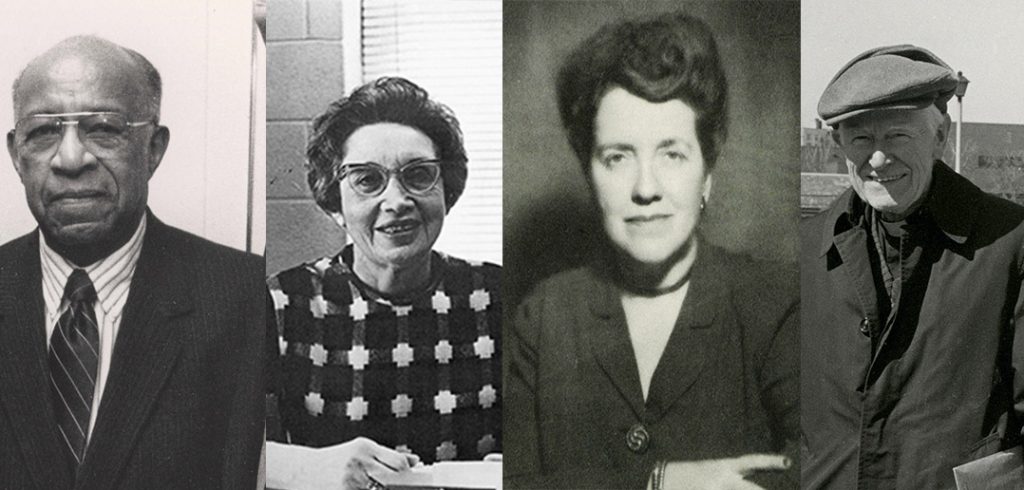Their names—Wynne, Diner, Blumensaat, King—are not among those more recognizable names associated with Fordham.
Yet the contributions of these and other former members of the Fordham faculty are equally distinguished. In many instances they left a lasting effect on their students and their fields of study, and on the underserved populations they championed.
As part of Fordham’s Dodransbicentennial celebration, several of these professors are the subject of an exhibit in the Fordham archives gallery, on the fourth floor of the William D. Walsh Family Library.
“We have many famous names associated with Fordham, persons whose achievements have brought distinction to the University,” said Patrice Kane, head of the University archives and special collections. “This exhibit focuses on those less-known people who did research and made scholarly and community contributions in a significant way. They helped create Fordham’s 175 years of service and wisdom.”
Ministering the Sick
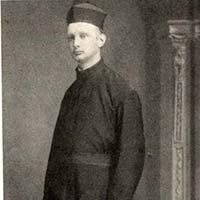 Kane found out about Hermann Blumensaat, S.J., a former professor of mathematics and music, when a man from Germany requested a photo of his headstone from the Rose Hill cemetery.
Kane found out about Hermann Blumensaat, S.J., a former professor of mathematics and music, when a man from Germany requested a photo of his headstone from the Rose Hill cemetery.
“He told me that Blumensaat and his friend, Henry Heide, invented Jujubes and Gummy Bears,” said Kane. “They made a million in the candy industry, and then Blumensaat decided he wanted to become a priest.”
After joining the Jesuit order, Father Blumensaat taught at Fordham while also ministering at Blackwell’s Island (now Roosevelt Island) in the charity and smallpox hospitals. When Heide’s son, Andrew, a Fordham student, became ill with pneumonia, Father Blumensaat cared for him until the student succumbed to the disease (Father Blumensaat later died of the disease himself, Kane said).
A Native American Advocate
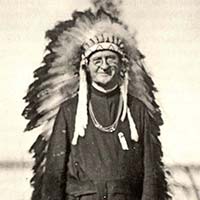 One of the more colorful professors featured, John J. Wynne, S.J., a faculty member in the School of Education, appears in a photo wearing an elaborate Indian headdress. It was a gift, Kane said, from the Mohawk Nation for his efforts in the early 20th century to promote the canonization of the first female Native American saint, Kateri Tekakwitha. (She was finally granted sainthood in 2012.)
One of the more colorful professors featured, John J. Wynne, S.J., a faculty member in the School of Education, appears in a photo wearing an elaborate Indian headdress. It was a gift, Kane said, from the Mohawk Nation for his efforts in the early 20th century to promote the canonization of the first female Native American saint, Kateri Tekakwitha. (She was finally granted sainthood in 2012.)
Father Wynne also helped to found the Jesuit magazine, America.
The Inventor
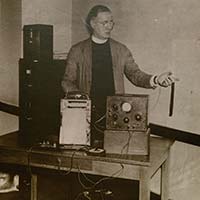 Before becoming a psychology professor in 1932, Walter Summers, S.J., invented a new form of lie detector test in 1930, a variation of the psychogalvanometer. The standard lie detector test of the day was the Keeler polygraph, which measured heartbeats and blood pressure. Father Summers’ invention, however, measured electrical currents on the skin.
Before becoming a psychology professor in 1932, Walter Summers, S.J., invented a new form of lie detector test in 1930, a variation of the psychogalvanometer. The standard lie detector test of the day was the Keeler polygraph, which measured heartbeats and blood pressure. Father Summers’ invention, however, measured electrical currents on the skin.
He joined with the New York City police force to test his machine against the standard. In 271 cases, it proved 98 percent accurate against Keller’s 50 percent.
The First Pharmacy Dean
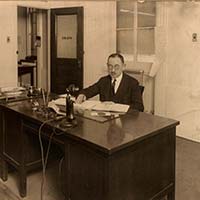 Fordham’s legacy of creating a welcoming space for those persecuted or less fortunate was evident in the early 20th century when a Russian-born Jew, Jacob Diner, M.D., persuaded Fordham’s Jesuits to open a pharmacy school. Diner, a graduate of Fordham’s School of Medicine, was subsequently named the School of Pharmacy’s first dean in 1912.
Fordham’s legacy of creating a welcoming space for those persecuted or less fortunate was evident in the early 20th century when a Russian-born Jew, Jacob Diner, M.D., persuaded Fordham’s Jesuits to open a pharmacy school. Diner, a graduate of Fordham’s School of Medicine, was subsequently named the School of Pharmacy’s first dean in 1912.
“A lot of people felt this was a Catholic college and took offense,” said Kane. “There were others who weren’t comfortable that he brought Jewish students to the school.”
Then-Jesuit Provincial Joseph Keating, S.J., University treasurer, rallied to Diner’s defense, said Kane. Diner remained dean until he retired in 1932, and the School of Pharmacy continued for nearly 40 more years.
The First Female Dean
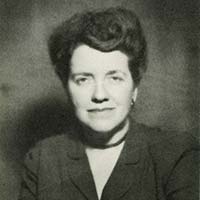 A Fordham “first” appointment was that of the first female dean at a Jesuit University. Anna E. King, Ph.D., a professor of casework, was appointed to the position of dean of the School of Social Service in 1939 by University President Robert Gannon, S.J. That dean’s appointment, too, was not without controversy; Father Gannon received a complaint from the Jesuit headquarters in Rome.
A Fordham “first” appointment was that of the first female dean at a Jesuit University. Anna E. King, Ph.D., a professor of casework, was appointed to the position of dean of the School of Social Service in 1939 by University President Robert Gannon, S.J. That dean’s appointment, too, was not without controversy; Father Gannon received a complaint from the Jesuit headquarters in Rome.
Nevertheless, King proved to be a savvy dean. “She was ahead of her time,” said Kane, who noted that, by 1945, King had been elected president of the American Association of Schools of Social Service. That same year, she initiated a master’s degree program in social service, and she served as dean until 1954.
An Activist for Puerto Rican Culture
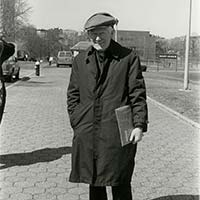 Joseph Fitzpatrick, S.J., a professor of sociology, helped found the Department of Sociology and Anthropology, but is remembered primarily as an activist for New York City’s bourgeoning Puerto Rican community. Kane said that Father Fitzpatrick wrote several books on Puerto Rican culture, and did research on what drove the development of street gangs in different sections of the city.
Joseph Fitzpatrick, S.J., a professor of sociology, helped found the Department of Sociology and Anthropology, but is remembered primarily as an activist for New York City’s bourgeoning Puerto Rican community. Kane said that Father Fitzpatrick wrote several books on Puerto Rican culture, and did research on what drove the development of street gangs in different sections of the city.
For his efforts, in 1978, Father Fitzpatrick was named Puerto Rican Man of the Year by a Puerto Rican community group—likely the only Irishman to receive the honor.
The Test Guru
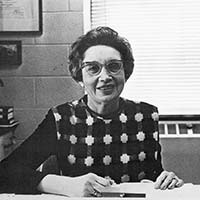 Anne Anastasi, Ph.D., received the National Medal of Science from President Ronald Reagan in 1987. Prior to that, Anastasi taught psychology at Fordham from 1947 to 1985, and also chaired the department. Nicknamed the “test guru”, Anastasi wrote a textbook, Psychological Testing, in 1954 that is considered by many to be the definitive text in the field of testing. The book is in its 9th printing.
Anne Anastasi, Ph.D., received the National Medal of Science from President Ronald Reagan in 1987. Prior to that, Anastasi taught psychology at Fordham from 1947 to 1985, and also chaired the department. Nicknamed the “test guru”, Anastasi wrote a textbook, Psychological Testing, in 1954 that is considered by many to be the definitive text in the field of testing. The book is in its 9th printing.
In 2008, Fordham created the Anne Anastasi Chair in Psychometrics and Quantitative Psychology in her honor; David V. Budescu, Ph.D., is the holder of the chair.
Emphasizing Child Welfare
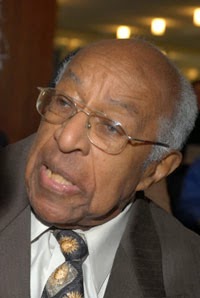 James R. Dumpson, Ph.D., lived his life breaking boundaries. He served as the first black commissioner of the Department of Welfare of the City of New York prior to coming to Fordham. When he was appointed dean of the Graduate School of Social Service in 1967 (the first black dean of a nonblack college’s school of social work), he recruited faculty from diverse backgrounds and experience, and built up a focus on child welfare.
James R. Dumpson, Ph.D., lived his life breaking boundaries. He served as the first black commissioner of the Department of Welfare of the City of New York prior to coming to Fordham. When he was appointed dean of the Graduate School of Social Service in 1967 (the first black dean of a nonblack college’s school of social work), he recruited faculty from diverse backgrounds and experience, and built up a focus on child welfare.
In 1974, he resigned to take on a new role as commissioner of the New York City Department of Social Services. He continued to teach classes as an adjunct professor.
He died in 2012 at the age of 103, but not without first seeing Brenda McGowan, D.S.W., appointed the Dumpson Chair in Child Welfare Studies in 2009.
Other more well-known names have made Fordham’s halls their home, including Nobel Prize winner Victor Hess (physics, 1938-56), Margaret Mead (anthropology, 1968-70), Marshall McLuhan (media, 1967-68) and Avery Cardinal Dulles (theology, 1988-2008).
Their stories, too, are part of the exhibit, which Kane says will be up through Fordham’s Dodransbicentennial year.
–Janet Sassi

